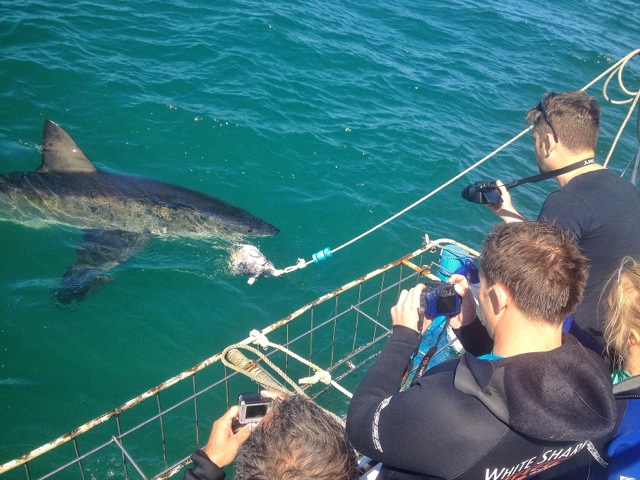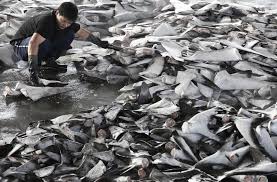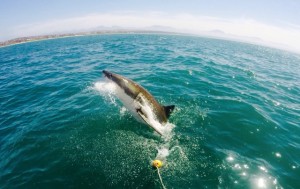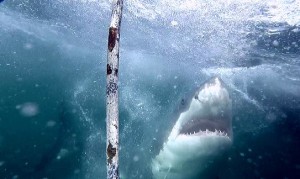News
Consider Cage Diving

Great white shark cage diving has become a growing industry in areas such as Australia, Mexico, and South Africa. Whether for an interest in sharks, an adrenaline rush, or a spontaneous vacation adventure, thousands of tourists eagerly plunge into cages to experience the great white shark in its natural environment.
Despite the growing industry, there are many controversial issues regarding white shark cage diving and the possible negative effects it may cause the animal. Some believe that sharks are drawn into areas they would not normally be. Others believe that chumming for sharks teaches them to associate boats – and humans – with food. The most controversial issue however must be around ensuring the safety of the sharks during cage diving activities as well as the safety of the divers in the cage. Many people believe that sharks are being purposely led or dragged into the cages to add to the excitement and experience of clients.
On the other hand there are many how believe that cage diving plays an important role towards promoting Shark conservation by raising awareness and trying to change the negative perception people have of these animals.
 Sharks are being killed worldwide at an unsustainable rate. It is estimated a staggering 100 million sharks die at the hands of humans each year. 70 million of those are thought to be as a result of shark finning. As the shark fin soup industry grows in China, it puts added pressure on fishermen to kill increasing numbers of sharks. In this particular industry, the fins are the focus of interest, leaving no concern for the well-being of the shark once the fins are removed. Often the shark is thrown back into the ocean, unable to swim which leads to death caused either by drowning or by becoming defenceless pray. Aside from the shark finning industry, sport fishing, beach nets, and by-catch are also aiding in diminishing shark numbers across the world. Currently, 90% of shark species are believed to be endangered.
Sharks are being killed worldwide at an unsustainable rate. It is estimated a staggering 100 million sharks die at the hands of humans each year. 70 million of those are thought to be as a result of shark finning. As the shark fin soup industry grows in China, it puts added pressure on fishermen to kill increasing numbers of sharks. In this particular industry, the fins are the focus of interest, leaving no concern for the well-being of the shark once the fins are removed. Often the shark is thrown back into the ocean, unable to swim which leads to death caused either by drowning or by becoming defenceless pray. Aside from the shark finning industry, sport fishing, beach nets, and by-catch are also aiding in diminishing shark numbers across the world. Currently, 90% of shark species are believed to be endangered.
It is a worldwide common misconception that the shark is to be a feared predator. This misunderstanding of the great white shark generates negative perspectives on the animal making support on issues concerning the sharks a challenging matter of contention.
White shark cage diving gives an opportunity for an understanding of the animal through education provided through crew members during the experience on the boat and inside the cage. As the clients see the sharks for themselves, a pre-conceived opinion of a mindless killer can change to that of respect and admiration for an apex predator. If no education or research is being done by white shark cage operators, then it is simply a business, contributing nothing to the protection and conservation to these animals, merely providing tourists with their great underwater photos of a massive shark.
 In South Africa, the right to own a cage diving permit is closely coupled with the responsibility to contribute towards conservation and research. A responsible cage diving company will remain within strict permit guidelines and adhere to criteria set by the Governing body. For instance, the bait handler’s job is to entice the sharks as close to the cage as possible, avoiding contact between the shark and the cage or boat. A skilled bait handler is able to keep the bait (usually a tuna head) out of reach, should the shark lunge towards it, but also avoid leading the shark to collide with the cage, which can be extremely difficult in low visibility conditions. If the shark decides to breach on the bait, the handler may not see it until it hits the surface. Throwing the bait out a safe distance from the cage minimizes the risk of the shark hitting or landing on the cage. Of course in this instance, the clients in the cage will see nothing of the shark underwater. It’s also important to remember that every shark behaves differently. Much like people, each have their own personality, making it difficult to predict the movements of a shark around the boat. The bait handlers most geared towards conservation will put shark safety above clients getting their close up.
In South Africa, the right to own a cage diving permit is closely coupled with the responsibility to contribute towards conservation and research. A responsible cage diving company will remain within strict permit guidelines and adhere to criteria set by the Governing body. For instance, the bait handler’s job is to entice the sharks as close to the cage as possible, avoiding contact between the shark and the cage or boat. A skilled bait handler is able to keep the bait (usually a tuna head) out of reach, should the shark lunge towards it, but also avoid leading the shark to collide with the cage, which can be extremely difficult in low visibility conditions. If the shark decides to breach on the bait, the handler may not see it until it hits the surface. Throwing the bait out a safe distance from the cage minimizes the risk of the shark hitting or landing on the cage. Of course in this instance, the clients in the cage will see nothing of the shark underwater. It’s also important to remember that every shark behaves differently. Much like people, each have their own personality, making it difficult to predict the movements of a shark around the boat. The bait handlers most geared towards conservation will put shark safety above clients getting their close up.
Conversing with clients is another important conservation tool that is used by most cage diving companies. With anything between 5-30 clients on a cage diving shark trip, there is a fantastic opportunity here for crew and biologists to be in conversation with clients about the animals they are seeing and the behaviour they are witnessing. Interesting facts conveyed in the right way make the trip educational and fun while helping to change the negative image attached to the sharks. Further information about the area they are in, as well as the food they eat is also important for understanding white shark behaviour. This makes having crew members that are passionate and open to taking with clients essential on the boat.
 For a responsible operator, client safety is extremely important. At the start of every tour, there is a safety briefing from a member of the crew or in the form of a video presentation. This outlines what the client can expect from the day, and in particular, how to make sure the day is safe for everyone on board. Emergency procedures should be explained in detail and the client should board the boat feeling safe and comfortable with the crew. As part of the safety briefing, clients are warned not to touch the sharks. This may seem like an obvious warning, but there have been many cases of divers wanting to get even closer, pushing their arms and cameras through the cage, leading to injuries caused either by the jaws or a shark’s tough skin. To avoid this most cages are built with an inner rail, for divers to hold on to and push themselves under water as sharks pass by. Those that try and touch sharks are usually removed from the cage.
For a responsible operator, client safety is extremely important. At the start of every tour, there is a safety briefing from a member of the crew or in the form of a video presentation. This outlines what the client can expect from the day, and in particular, how to make sure the day is safe for everyone on board. Emergency procedures should be explained in detail and the client should board the boat feeling safe and comfortable with the crew. As part of the safety briefing, clients are warned not to touch the sharks. This may seem like an obvious warning, but there have been many cases of divers wanting to get even closer, pushing their arms and cameras through the cage, leading to injuries caused either by the jaws or a shark’s tough skin. To avoid this most cages are built with an inner rail, for divers to hold on to and push themselves under water as sharks pass by. Those that try and touch sharks are usually removed from the cage.
In the case of bad weather conditions, trips are usually cancelled. Should a trip go ahead in poor conditions, the experience in the shark cage can be very unpleasant. If an operator goes out in poor conditions, it shows more of a focus on business than shark conservation.
In order to save sharks from extinction it is important for clients who seek the cage diving experience to be given the opportunity to see not only how sharks behave in the wild, but also factual information given by passionate crew members. This type of mindset spreading throughout the world gives a chance for positive outlooks and attitudes towards the sharks.
To find out more about Shark Conservation opportunities and how you can make a difference visit www.wsaecoprogram.co.za.
[youtube id=”0qDVgRs5ZIs” width=”100%” height=”400px”]
Blogs
Northern Red Sea Reefs and Wrecks Trip Report, Part 3: The Mighty Thistlegorm

Jake Davies boards Ghazala Explorer for an unforgettable Red Sea diving experience…
Overnight, the wind picked up, making the planned morning dive a bit bumpy on the Zodiacs to the drop point on Thomas Reef. There, we would dive along the reef before descending through the canyon and then passing under the arch before ascending the wall with a gentle drift. The site provided great encounters with more pelagic species, including shoals of large barracuda, tuna, and bigeye trevally.
Once back on the boat, it was time to get everything tied down again as we would head back south. This time, with the wind behind us, heading to Ras Mohammed to dive Jackfish Alley for another great gentle drift wall dive before then heading up the coast towards the Gulf of Suez to moor up at the wreck of the Thistlegorm. This being the highlight wreck dive of the trip and for many onboard, including myself, it was the first time diving this iconic wreck. I had heard so much about the wreck from friends, and globally, this is a must on any diver’s list. Fortunately for us, there was only one other boat at the site, which was a rarity. A great briefing was delivered by Ahmed, who provided a detailed background about the wreck’s history along with all the required safety information as the currents and visibility at the site can be variable.

Kitting up, there was a lot of excitement on deck before entering the water and heading down the shoreline. Descending to the wreck, there was a light northerly current which reduced the visibility, making it feel more like the conditions that can be found off the Welsh coast. At 10m from the bottom, the outline of the wreck appeared as we reached the area of the wreck which had been bombed, as our mooring line was attached to part of the propeller shaft. Arriving on deck, instantly everywhere you looked there were many of the supplies which the ship was carrying, including Bren Carrier tanks and projectiles that instantly stood out.

We headed around the exterior, taking a look at the large propeller and guns mounted on deck before entering the wreck on the port side to take a look in the holds. It was incredible to see all the trucks, Norton 16H, and BSA motorcycles still perfectly stacked within, providing a real snapshot in time.

Overall, we had four dives on the Thistlegorm, where for all of the dives we were the only group in the water, and at times, there were just three of us on the whole wreck, which made it even more special, especially knowing that most days the wreck has hundreds of divers. Along with the history of the wreck, there was plenty of marine life on the wreck and around, from big green turtles to batfish, along with shoals of mackerel being hunted by trevally. Some unforgettable dives.

The final leg of the trip saw us cross back over the Suez Canal to the Gobal Islands where we planned to stay the night and do three dives at the Dolphin House for the potential of sharing the dive with dolphins. The site, which included a channel that was teeming with reef fish, especially large numbers of goatfish that swam in large shoals along the edge of the reef. These were nice relaxing dives to end the week. Unfortunately, the dolphins didn’t show up, which was okay as like all marine life they are difficult to predict and you can’t guarantee what’s going to be seen. With the last dive complete, we headed back to port for the final night where it was time to clean all the kit and pack before the departure flight the next day.

The whole week from start to finish on Ghazala Explorer was amazing; the boat had all the facilities you need for a comfortable week aboard. The crew were always there to help throughout the day and the chefs providing top quality food which was required after every dive. The itinerary providing some of the best diving with a nice mixture of wreck and reef dives. I would recommend the trip to anyone, whether it’s your first Red Sea liveaboard in the Red Sea or you’re revisiting. Hopefully, it’s not too long before I head back to explore more of the Red Sea onboard Ghazala Explorer.

To find out more about the Northern Red Sea reef and wrecks itineraries aboard Ghazala Explorer, or to book, contact Scuba Travel now:
Email: dive@scubatravel.com
Tel: +44 (0)1483 411590
Photos: Jake Davies / Avalon.Red
Blogs
Northern Red Sea Reefs and Wrecks Trip Report, Part 2: Wall to Wall Wrecks

Jake Davies boards Ghazala Explorer for an unforgettable Red Sea diving experience…
The second day’s diving was a day full of wreck diving at Abu Nuhas, which included the Chrisoula K, Carnatic, and Ghiannis D. The first dive of the day was onto the Chrisoula K, also known as the wreck of tiles. The 98m vessel remains largely intact where she was loaded with tiles which can be seen throughout the hold. The stern sits at 26m and the bow just below the surface. One of the highlights of the wreck is heading inside and seeing the workroom where the machinery used for cutting the tiles are perfectly intact. The bow provided some relaxing scenery as the bright sunlight highlighted the colours of the soft coral reef and the many reef fish.

Following breakfast, we then headed to the next wreck, which was the Carnatic. The Carnatic is an 89.9m sail steamer vessel that was built in Britain back in 1862. She ran aground on the reef back in 1869 and remains at 27m. At the time, she was carrying a range of items, including 40,000 sterling in gold. An impressive wreck where much of the superstructure remains, and the two large masts lay on the seafloor. The wooden ribs of the hull provide structures for lots of soft corals, and into the stern section, the light beams through, bouncing off the large shoals of glass fish that can be found using the structure as shelter from the larger predators that are found outside of the wreck.

The final wreck at Abu Nuhas was the Ghiannis D, originally called ‘Shoyo Maru,’ which was 99.5m long and built in Japan back in 1969 before becoming a Greek-registered cargo ship in 1980. The ship then ran aground on the reef on April 19th, 1983, and now sits at the bottom at a depth of 27m. Heading down the line, the stern of the ship remains in good condition compared to the rest of the hull. The highlight of the wreck, though, is heading into the stern section and down the flights of stairs to enter the engine room, which remains in good condition and is definitely worth exploring. After exploring the interior section of the ship, we then headed over to see the rest of the superstructure, where it’s particularly interesting to see the large table corals that have grown at the bow relatively quickly considering the date the ship sank. After surfacing and enjoying some afternoon snacks, we made sure everything was strapped down and secured as we would be heading north and crossing the Gulf of Suez, where the winds were still creating plenty of chop.

The next morning, it was a short hop to Ras Mohammed Nature Reserve for the next couple of days of diving. The 6am wake-up call came along with the briefing for the first site we would be diving, which was Shark & Yolanda. The low current conditions allowed us to start the dive at Anemone City, where we would drift along the steep, coral-filled wall. These dives involved drifts, as mooring in Ras Mohammed wasn’t allowed to protect the reefs. As a dive site, Shark & Yolanda is well-known and historically had a lot of sharks, but unfortunately not so many in recent years, especially not so early in the season. However, there was always a chance when looking out into the blue.

The gentle drift took us along the steep walls of the site, with plenty of anemone fish to be seen and a huge variety of corals. It wasn’t long into the dive before we were accompanied by a hawksbill turtle, who drifted with us between the two atolls before parting ways. Between the two reefs, the shallow patch with parts of coral heads surrounded by sand provided the chance to see a few blue-spotted stingrays that were mainly resting underneath the corals and are always a pleasure to see. With this being the morning dive, the early sunlight lit up the walls, providing tranquil moments. Looking out into the blue, there was very little to be seen, but a small shoal of batfish shimmering underneath the sunlight was a moment to capture as we watched them swim by as they watched us.

Towards the end of the dive, we stopped at the wreck of the Jolanda where the seafloor was scattered with toilets from the containers it was carrying. This provided a unique site to make a safety stop, which was also accompanied by a large barracuda slowly swimming by, along with a hawksbill turtle calmly swimming over the reef as the sun rays danced in the distance.
For the next dive, we headed north to the Strait of Tiran to explore the reefs situated between Tiran Island and Sharm El Sheik, which were named after the British divers who had found them. We started on Jackson before heading to Gordons Reef, where we also did the night dive. All the atolls at these sites provided stunning, bustling coral reefs close to the surface and steep walls to swim along, which always provided the opportunity to keep an eye out for some of the larger species that can be seen in the blue. Midwater around Jackson Reef was filled with red-toothed triggerfish and shoals of banner fish, which at times were so dense that you couldn’t see into the blue. Moments went by peacefully as we enjoyed the slow drift above the reef, watching these shoals swim around under the mid-afternoon sun.

The night dive at Gordon’s Reef was mainly among the stacks of corals surrounded by sand, which was great to explore under the darkness. After some time circling the corals, we came across what we were really hoping to find, and that was an octopus hunting on the reef. We spent the majority of the dive just watching it crawl among the reef, blending into its changing surroundings through changes in colour and skin texture. It’s always so fascinating and captivating to watch these incredibly intelligent animals, in awe of their ability to carry out these physical changes to perfectly blend into the reef. Before we knew it, it was time to head back to the boat to enjoy a well-deserved tasty dinner prepared by the talented chefs onboard.
Check in for the 3rd and final part of this series from Jake tomorrow!
To find out more about the Northern Red Sea reef and wrecks itineraries aboard Ghazala Explorer, or to book, contact Scuba Travel now:
Email: dive@scubatravel.com
Tel: +44 (0)1483 411590
Photos: Jake Davies / Avalon.Red
-

 News3 months ago
News3 months agoHone your underwater photography skills with Alphamarine Photography at Red Sea Diving Safari in March
-

 News3 months ago
News3 months agoCapturing Critters in Lembeh Underwater Photography Workshop 2024: Event Roundup
-

 Marine Life & Conservation Blogs2 months ago
Marine Life & Conservation Blogs2 months agoCreature Feature: Swell Sharks
-

 Blogs2 months ago
Blogs2 months agoMurex Resorts: Passport to Paradise!
-

 Blogs2 months ago
Blogs2 months agoDiver Discovering Whale Skeletons Beneath Ice Judged World’s Best Underwater Photograph
-

 Gear Reviews3 months ago
Gear Reviews3 months agoGear Review: Oceanic+ Dive Housing for iPhone
-

 Marine Life & Conservation2 months ago
Marine Life & Conservation2 months agoSave the Manatee Club launches brand new webcams at Silver Springs State Park, Florida
-

 News3 months ago
News3 months agoWorld’s Best Underwater Photographers Unveil Breathtaking Images at World Shootout 2023
















